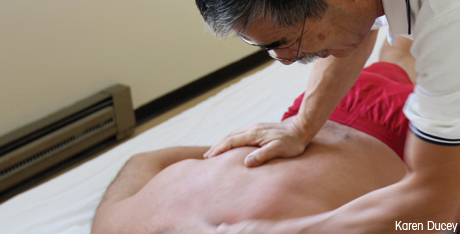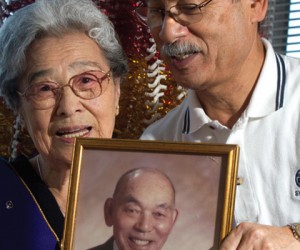Mike Kazunori Shimizu has been practicing shiatsu in Seattle for close to 40 years. He is his own boss and his only employee — his answering machine serves as his secretary. Dressed in his customary shorts and tennis shoes, it’s easy to mistake this trim, gray-tinged sexagenarian as the community basketball coach rather than the renowned healer and philanthropist that he is. Affable and vigorous, this enigmatic man is both a pleasure to know and, at the same time, hard to understand.
I cannot remember which ailment first landed me in Mike’s office; over the years he has helped me with hip and back pain, thyroid problems, carpal tunnel syndrome, and tennis elbow — just a few of the many illnesses he treats. In just 30 minutes it’s possible to leave his office more aware of, and present in, your body and more connected to your limbs, yourself and the ground on which you stand.
According to Japanese records, the original practitioner of Sennin-So shiatsu was a 15th-century blind Buddhist monk who treated female members of the royal houses — chosen for this role because only the unsighted were allowed this privilege.
Shiatsu (literally “shi,” finger and “atsu,” pressure) is a Japanese healing technique based on the philosophy of traditional Chinese medicine, which emphasizes the “qi” or the body’s energy meridians, and uses finger pressure to calm the body’s nervous system.
Mike practices Sennin-So, a unique form of shiatsu founded by the Shimizu family and handed down for 33 generations. According to Japanese records, the original practitioner of Sennin-So shiatsu was a 15th-century blind Buddhist monk who treated female members of the royal houses — chosen for this role because only the unsighted were allowed this privilege. According to family legend, this monk was Mike’s direct ancestor, and though the details of this Buddhist monk’s life have been lost to the mists of time, the familial ancestry remains a vital part of Mike’s family story and professional practice.
Mike was born to father Sengo and mother Haruko, both Japanese natives who had lived in the U.S. They met shortly before their arranged marriage in Japan in 1935, after which they returned to the U.S. and started a family in Salinas, California.
With the beginning of the war with Japan, Sengo, an involved community leader, was picked up by the FBI and confined to an internment camp in California. Haruko soon followed. By the time they were released from a second internment camp in Texas, the couple had four children.
When the war ended, and having lost everything they had built in the U.S., Sengo and Haruko returned with their children to Hiroshima. There Sengo began to practice Sennin-So shiatsu and utilize the techniques his father had taught him when he was a child. Two years later, Mike was born.
When Mike was 14, Sengo and Haruko decided to return to the U.S. with their five children, believing that their lives would be better here. They settled in Seattle — where Sengo set up his shiatsu practice in the International District and where, eventually, both Mike and his brother Roy apprenticed with their father.
It wasn’t until 1972, after Mike had attended the University of Washington and served as an Army medic in Vietnam, that Sengo invited him to begin his shiatsu career. From then until Sengo’s death at the age of 80, father and son worked side by side. To this day, Mike continues to practice in the same space he shared with his father, and he keeps his father’s nameplate next to his office door.
From the time Mike was a child, his father taught him to appreciate shiatsu.
For Mike, his father’s legacy is more than the name plate. Sengo still exists within him and has an impact on his work every day. Mike continues to rely on his father’s and grandfather’s wisdom, explaining it in simple terms: “Do you ever ask your father or grandfather for help? I do. I ask them for help when challenging patients walk through my door. I ask them what to do. Their answer comes through the energies in my hands and fingers. I’m constantly communicating with my ancestors.”
From the time Mike was a child, his father taught him to appreciate shiatsu. “It was subtle,” says Mike. “My dad rubbed my shoulders, and it felt good, so I began to ask for massages. As I got older, my dad taught me how to practice. I had my first patient in Japan when I was eight years old; I treated a man for tennis elbow.”
Mike learned the art of diagnosis from his father, which he practices to this day, often without his clients’ awareness. He asks them questions about their lives and diet and watches how they sit and walk. He notes the color of their skin and eyes, the smell of their breath, and the sensitive spots in their bodies.
From his father, Mike learned to work the pressure points in the groin, the armpits and the eyebrow. He learned to flush the dormant blood (lactic acid) in the muscles and to stimulate blood circulation in areas of stagnation, reducing the tension and stiffness that result from circulatory congestion and then restoring the body to its normal functioning.
Also from his father, Mike learned that balance is not only what one needs in life, but also what one needs in one’s own body. “Here in America,” says Mike, “we eat too many sweets. We have too much stress. Sweets and stress create acid. We get ulcers, abdominal cancer, and colon cancer because our systems are too acidic.”
The solution is simple, according to Mike: “Keep the body more alkaline.” His recommendation? Take a quarter to a half teaspoon of baking soda three times a day to neutralize the body’s pH balance.
Also from his father, Mike learned that balance is not only what one needs in life, but also what one needs in one’s own body.
You may doubt his techniques; they don’t jibe with Western medicine, and there are no double blind studies to support their efficacy. Yet the anecdotal and historical evidence is there, passed down through generations of healers and their patients. And there is no way you will convince Mike’s clients, thousands of them from all over the world, to stop seeing him. His mother Haruko, still spry at 96 and a celebrated practitioner of Mizuhiki, the ancient Japanese art of weaving colored paper cords, comes to his office for her monthly treatments.
Perhaps Haruko is biased.
So plant yourself in his waiting room and talk to his patients. You will hear comments like, “I just walk in, and he looks at me and knows what is wrong.” Or, “He got me off medication for diabetes.” Or simply, “He saved me.” Even my father, a man who is beyond skeptical about alternative medicine, declared, “If Mike lived in Baltimore, I’d see him every week.”
To my knowledge, Mike is not planning to retire anytime soon, for which I’m grateful. None of the four children he’s had with wife Alex (a Caucasian Washingtonian) are interested in carrying on the Sennin-So shiatsu tradition.
Does this mean the end of the line for the 33 generations of Sennin-So masters? Mike is surprisingly relaxed about the answer. His father Sengo began practicing after farming for many years, and his brother Roy had a full career in engineering before deciding to practice Sennin-So shiatsu professionally. So perhaps there is still time for one of his children to take up the practice. Mike doesn’t pressure them. Like his father before him, his philosophy for his children is “Whatever you do, do it well.”
None of the four children he’s had with wife Alex are interested in carrying on the Sennin-So shiatsu tradition.
Whatever happens to the future of the Sennin-So shiatsu tradition, I can say this: there is something significant about being tended to by a practitioner who is part of a long line of practitioners. When Mike works on me, I feel his ancestors in the room, and I feel the strength of a long tradition of support and healing.
Reverend Don Castro of the Seattle Buddhist Church, where Mike and his family have been members for years, explained the Buddhist idea of the importance of one’s ancestors and of owing gratitude to them. He offered this quote by Shinran Shonin, founder of Jodo Shinshu Buddhism, who lived from 1173–1263:
“I have gathered the true words so they may help others to practice the way to enlightenment. My wish is that those who have attained enlightenment will lead those who come after them, and those who aspire to enlightenment will follow their predecessors, thus following one after another endlessly and uninterruptedly until this boundless sea of birth and death is exhausted.”
Castro also spoke to the responsibility of the current generation to show gratitude to their ancestors by giving to people they meet throughout their lives.
Mike repays his gratitude to his ancestors not only through his practice of shiatsu, but also by giving to those less fortunate than himself. In his office, he showcases four charities: Soles for Souls, Penny Harvest, Kids Without Borders, and The Wheelchair Foundation. Through his Rotary Club, and the Rotary 5030 Service Fund, Mike and Alex have established a fund to help The Wheelchair Foundation. Each year the couple organizes trips to countries like Mexico, Guatemala, Honduras, Uganda, Ethiopia and Vietnam to personally deliver wheelchairs, food and medical supplies. In the past 10 years, Mike and Alex have delivered 5,580 wheelchairs to adults and children in need.
At first, talking to Mike, I felt like one of those blind monks, groping around, unable to make his story fit into my sense of tradition. How to rationalize his loyalty and service to this country, despite how the U.S. treated his family? Or his strong cultural identification to Japan alongside his deep ties through marriage and family to the U.S.? And how to account for his strong connection to the roots of Sennin-So shiatsu and his apparent nonchalance about its continuation?
It wasn’t until I recalled something he’d said that this healer came into focus. “If all anyone says about me after I’m gone is: ‘I remember Mike; he helped me,’ that will be enough. That will be how my life will continue to live on.”
That would be a fine legacy for anyone.




